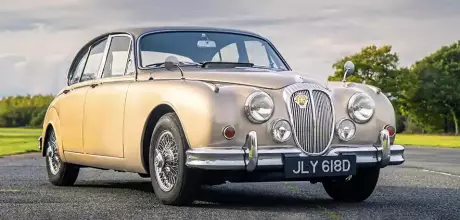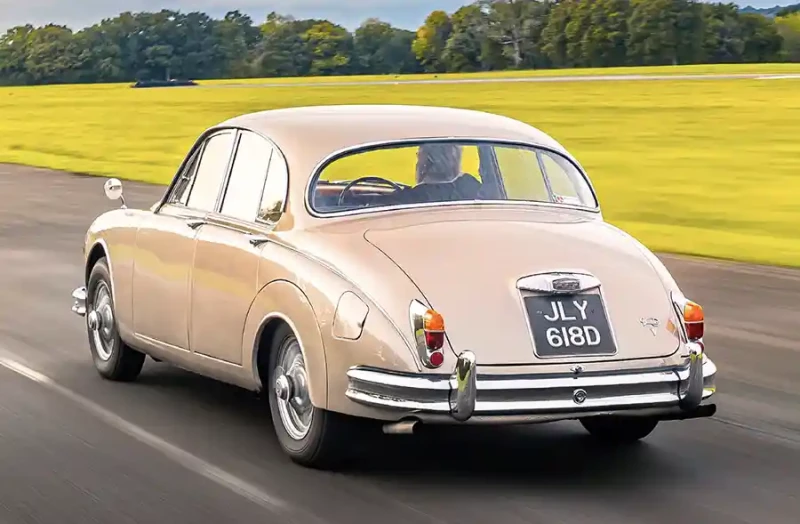Buying Guide Daimler V8

A bargain compared to its self-consciously iconic Jaguar Mk2 sibling, this compact, lively, luxurious Daimler makes a great buy. If you arm yourself with the right knowledge.
How to buy the underrated V8 take on the Jaguar Mk2
Words CHRIS HOPE
Photography JONATHAN FLEETWOOD
Buying Guide Is the Daimler V8 the best Jaguar Mk2 variant? Find out for yourself
Unthinkable though it may have seemed in the Sixties, the Daimler 2.5 V8 saloon and its later 250 iteration are now the best-value way into that compact Jaguar saloon range. It possesses the kind of oomph and luxury you just don’t get in the similarly affordable but lowly Jaguar 240, and yet it undercuts the more powerful 3.4 and 3.8-litre Mk2s. The V8 in the nose is shorter and lighter than the Jaguar XK too, so the Daimler is less prone to understeer. Arguably it’s not just the best-value of the Jaguar Mk2 range, it’s the best fullstop. You can even get 22mpg out of it.

However, their less-loved status over the years, and the unusual engine compared to the ubiquity of the Jaguar XK, means many have been neglected and bodged. To guide us to a good one, we spoke to the Daimler and Lanchester Owners’ Club, classic Jaguar specialist David Manners, and Daimler V8 engine specialist Robert Grinter.
Which is which?
Launched in 1962, the Daimler 2.5 V8 was based on the three-year-old Jaguar Mk2. Externally, badging aside, the only difference was the radiator grille – the Daimler’s featured 20 slats, a fluted chrome surround, a ‘Flying D’ bonnet mascot and a fluted boot plinth.
Under the skin, however, was that Edward Turner-designed V8. In the cabin, front seat passengers sat on a split full-width leather bench seat, and the dashboard and centre console differed from the Jaguar to accommodate. Rear seat passengers did without fold-down picnic tables – legroom was deemed more important. Overdrive was optional, as was power-assisted steering, and the radio installation options were extensive, including parcel shelf-mounted stereo speakers.
As the rest of the Jaguar range was given three-number engine-related monikers in 1967, the Daimler was renamed the V8 250. Manual gearboxes became all-synchromesh units, and the same singleblade bumpers as the rest of the Jaguar range were adopted. A minor interior restyle included perforated leather on the seats, and safety-conscious padded vinyl on the dashboard top and door cappings. The engine remained the same, however. The model was finally discontinued in 1969.
Bodywork and structure
Sharing a bodyshell with the Jaguar Mk2 means the same corrosion issues apply, as does the potential for eye-watering restoration costs.
Surface rot will likely be much worse underneath, so concentrate on the lower six inches of bodywork especially the lower wings, inner and outer sills, door bottoms, and front/rear valances. Wheelarches rust, along with the front panel and around the headlamps. Bonnet and bootlid aside, most panels and repair sections are available, but quality parts – needed to avoid major reworking – are costly. Front wings, for example, cost £2500 each, even before fitting and painting are factored in.
Many examples have been restored at least once but the quality of the work that has been carried out is crucial, so inspect carefully and look for paperwork showing who did it. Whatever the history, get a prospective purchase on a ramp because the chassis legs and cabin and boot floors have a tendency to dissolve away, and checking the rear spring hangers is vital; the double-skinned ‘top hat’ sections rot from the inside so a cursory prod isn’t enough. It’s important to check the exterior chromework; a replacement bumper can exceed £1000 and the later slim items often corroded more quickly.
Engine
A complete engine overhaul can cost £8000 or more at a specialist so don’t rush the mechanical checks. Oil pressure should be at least 40psi when warm; look for smoke from the exhaust, indicating cylinder/piston wear. A leaking rear crankshaft seal is common. The original rope seal can be upgraded with a modern rubber part but fitting the kit requires some machining. Listen for the rattle of a worn timing chain, something exacerbated by lack of regular oil changes. Neither the fuel nor ignition systems pose any real problems; both are pleasingly straightforward to overhaul, with parts plentiful. A healthy cooling system is paramount because overheating will quickly compromise the cylinder head gaskets. Corroded or silted-up waterways within the alloy heads are a further worry, so keep a close eye on the temperature gauge – treat any signs of hot running or coolant loss as a warning. And if the fan runs all the time, the viscous coupling has failed and new replacements aren’t available.
Fitting electronic ignition is good for reliability and engine running on most classics, but the Daimler V8’s peculiar twin-points set-up is an added complexity you can do without. Any reputable aftermarket kit will suffice.
Gearbox
The Borg-Warner 35 auto ’box is tough but needs regular fluid changes, or expect to pay around £1000 for a specialist overhaul. Equally robust is the manual transmission but check for whining or crunching synchromesh, and bear in mind that the clutch is unique to the Daimler. Minor whines aside, the rear axle is good for 200k miles unless it’s run low on oil. Fitting a five-speed ’box is the ultimate, costing £1500 plus shipping from conversioncomp.co.nz, and you’ll need to source a Tremec T5 as solution to the Daimler’s short gearing. A cheaper and simpler way to improve fuel economy is to swap the 4.27:1 axle ratio for a 3.54:1 from other Jaguar models.
Brakes, suspension and steering
The Adwest power steering is prone to fluid leaks, especially where the input shaft enters the steering box. It’s heavy without but fitting one requires the matching front subframe. Smaller, third-party electronic systems are simpler to fit – though you will need to convert to negative earth and fit a high output alternator to complete the job.
Lack of use will seize the brakes and a complete overhaul can exceed £1000 in parts alone, so ensure they respond well on the test-drive. As for the suspension, aside from rot around the mounting points, it’s worth checking if the front springs/ dampers are of the correct specification; the lighter V8 meant they differed from the Jaguar Mk2 items. There should be a 60mm gap between the top of the tyre and the wheelarch – if it’s sitting too high it might have been fitted with parts rated for the Jaguar. And finally, check for wear in the hubs/wheel splines if wire wheels are fitted by jacking up the car and attempting to rock each wheel.
Upgrading to four-piston front brake calipers is a common upgrade, your £829 plus fitting giving much more modern stopping power. Vented discs are available, but only really necessary for track use. Thanks to cross-over with the Jaguar Mk2, kits are available to convert the rear leaf-sprung suspension to a new design with coils at at £2800, plus fitting. Installing this helps put the V8’s power down much better over uneven surfaces, and minimises unwanted lateral movement.
Electrics
Age-related issues aside, electrical troubles aren’t common although it’s worth checking the condition of the connection points on each side of the engine bay. On the multitude of bullet connectors, corrosion can lead to a host of issues with lighting; a new loom costs £400. Last, make sure you check the operation of the various cabin switches thoroughly, because finding replacements – the glovebox light switch, for example – can be tricky, meaning a potentially lengthy hunt for secondhand parts.
1965 Daimler 250 V8 £29,995
‘This beautiful example has been subject to a complete restoration to a very high standard, carried out over a number of years. All the components were either rebuilt or renewed. Over £40,000 was spent on the restoration including engine and transmission. Finished in Old English White with Jaguar/Daimler old red interior. The seats are the original hide with very light patina. Fitted with new carpets and headlining. All the wood veneers have been restored to a very high standard. Virtually all the chrome was replaced with new-old stock Jaguar parts. The car won several awards at classic car shows last year. If you are looking for a Daimler 250 and only want the best, don't miss this one.’
‘Their less-loved status over the years means many were neglected and bodged...’

Beautiful Daimler 2.5/250 heftily undercuts Jaguar siblings. Daimler 2.5-litre V8 engine defines Refinement.
Daimlers had higher levels of luxury, so check everything’s in good condition. Beware of rust – replacing panels quickly gets expensive.
‘Arguably it’s not just the best-value of the Mk2 range, it’s the best full-stop’
What to pay
- The Daimler V8 range is a bargain compared to its Jaguar Mk2 sibling. There’s no discernable price difference between early V8s and later 250s either – these are cars to be bought on condition alone. Usable examples start at £8000.
- Very good private-sale cars can be had for £13,000, with showworthy examples commanding £20,000.
- Dealers will charge up to £25,000, but there isn’t nearly as much enthusiasm for them in the trade as there is for their Jaguar siblings.

